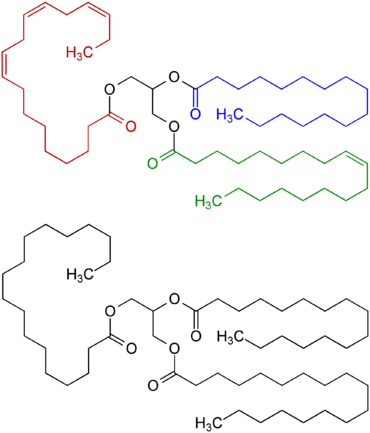Rancid (fat)

Rancid is the name given to the state in which fats and other lipids break down through oxidation or through fat-splitting enzymes ( lipases ).
course
The spoilage of vegetable and animal fats, which can already be perceived in the early stages through a change in smell and taste (rancidity), is due on the one hand to hydrolysis and the associated breakdown of longer-chain fats in the case of water-containing fats and on the other to the effects of atmospheric oxygen (oxidation) . The oxidation processes that proceed slowly at room temperature and faster with increasing temperature are referred to as autoxidation or also as lipid peroxidation . They begin with radical reactions on unsaturated fatty acids and lead in a multi-stage process to various degradation products, in particular peroxides , alcohols , aldehydes and carboxylic acids .
The most prone to spoilage are fats with a high proportion of unsaturated fatty acid residues. The tendency of (monounsaturated) oleic acid residues to oxidize is around a factor of 100 higher than that of (saturated) stearic acid residues, in the case of polyunsaturated linoleic acid residues even by a factor of 1200, and in the case of linolenic acid residues by a factor of 2500 For example, linseed oil or walnut oil , which have a high content of glycerides of linolenic and linoleic acid, should be kept in the refrigerator and not heated. Oils with a high proportion of linoleic acid residues, such as conventional sunflower or safflower oil , should only be used for steaming at low temperatures. Oils with a high content of glycerides of oleic acid, such as olive and rapeseed oil , but also peanut oil and so-called high oleic sunflower oil , on the other hand, can be used for frying and deep-frying at temperatures of up to 170 ° C and are a sensible alternative to saturated fats which can be heated to a higher temperature and have a longer shelf life and are therefore particularly used in the catering sector.
In the case of other damage caused by microbiological infestation with molds, yeasts or bacteria, one does not speak of rancidity, but of microbial spoilage .
Pure fats are water-free and only spoil through the oxygen reaction described above. Water-in-oil emulsions such as butter (as opposed to pure butter fat ) and margarine or oil-in-water emulsions such as cream, milk and mayonnaise, on the other hand, can also spoil through hydrolytic cleavage, the same applies to areas that have been in contact with water for a long time of pure fats, for example in the form of condensed water. Lipases that either were already in the fat or are produced by microorganisms can also be involved in the hydrolytic breakdown .
The higher the water content in a fat-water mixture, the faster microbial contamination can develop.
consequences
The reaction products are often malodorous or bad-tasting substances (including free fatty acids ) that make food and edible oils inedible. Some foods (such as linseed oil and walnut oil ) go rancid very quickly if left unrefrigerated. The fats and oils that go rancid particularly quickly contain a high proportion of triglycerides of unsaturated fatty acids (mostly linoleic acid and linolenic acid ). In addition to the oxidation of the unsaturated bond, there is also oxidative cross-linking in the case of polyunsaturated fats (e.g. linseed oil oxidizes to linoxin ).
The process sometimes forms an airtight and watertight rind on the surface of food and also helps with the drying of oil paint . Butter becomes yellowish-translucent to dark and cracked. Cooking oil becomes thick and finally more and more viscous.
Health effects
The rancid smell (and taste) alone usually prevents one from consuming rancid products. However, spicy dishes can be problematic. Only in extreme situations (depending on the oil when heating to approx. 400 ° C ) - when grilling food, for example - more polycyclic aromatic hydrocarbons (PAHs) are formed, which in laboratory tests are carcinogenic. Repeatedly strong heating of one and the same fat, for example in deep fryers, should also be viewed critically. The reaction accelerated by heat leads to an ever increasing saturation of the amount of oil with decomposition products, which can be harmful to health.
protection
Sensitive oils and fats, i.e. fats with a high proportion of polyunsaturated fatty acids bound in the triglyceride , are kept refrigerated in closed containers. It is beneficial to use vessels that are opaque (sheet metal) or not very translucent (dark glass), which extends the shelf life. Freezing also protects, but sensory quality deterioration is to be expected, especially with repeated freezing. Particularly in the case of water-based fat mixtures, increased freezing can increase the microbiological susceptibility, ie the product then becomes more susceptible to germs and is more heavily contaminated with them. Antioxidants such as carotene , ascorbic acid and tocopherol , which can be added to food, make them more durable.
In the industrial production of margarine , the double bonds are saturated by reduction with hydrogen . This increases the best-before date , even if most of the essential fatty acid residues are hydrogenated to saturated fatty acid residues, which can only be used to a lesser extent in cell membranes as membrane lipids , but mainly serve as storage fats.
Intended application
In the case of raw milk cheese , on the other hand, the milk fat is broken down by the milk's own lipases during ripening. The end products improve the aroma of the cheese in significantly weaker concentrations than when they go rancid .
Individual evidence
- ↑ a b Bertrand Matthäus: Behavior of different cooking oils during deep-frying. (PDF; 270 kB). Institute for Lipid Research of the Federal Institute for Grain, Potato and Fat Research, 2002.
- ↑ Interview with Prof. Dr. Gerhard Billek ( Memento from August 13, 2012 in the Internet Archive ).